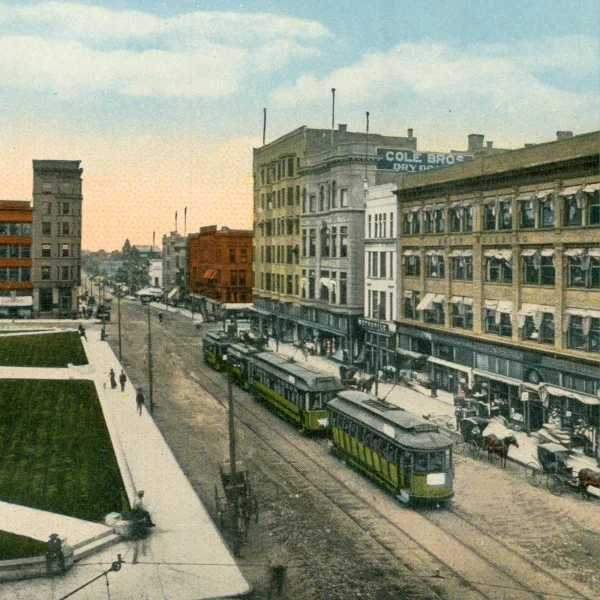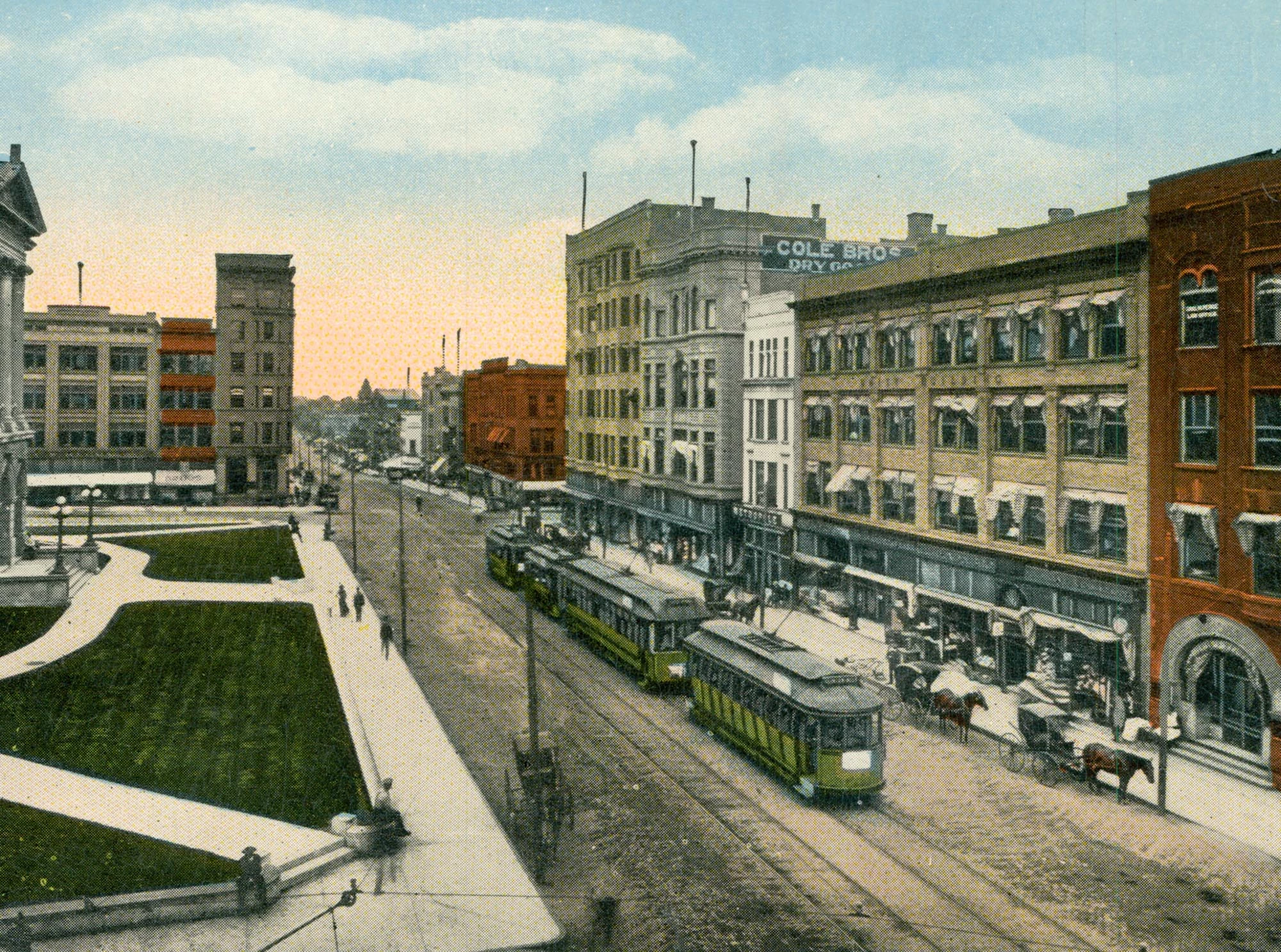“Let the slogan of the day be, ‘Ride for Charity,’” announced the Jul. 6, 1911 Pantagraph. “Leave the automobile un-cranked and keep the horse in the barn, for the streetcar needs you.”
What the streetcars needed on this summer day more than a century ago were lots of riders, preferably those of generous spirit with plenty of extra change jingling in pocketbook or purse. Why’s that? Well, off and on, beginning in the 1890s and continuing for about two decades, the Bloomington-Normal streetcar system played host to an annual Trolley Day fundraiser. Organized by philanthropically minded upper-middle and upper-class society women, these charity events involved devoting a day’s worth of streetcar fares to the local benevolent association, which provided needed assistance to the most destitute of the city’s residents.
“Everybody who rides will contribute to the fund to be dispersed in aiding the worthy poor during the long, cold winter,” reported The Pantagraph on the Sep. 26, 1899 Trolley Day. “This being the fact, all should ride, and ride early and often.”
To boost ridership on Trolley Day, the streetcar conductors were replaced with young society women ranging in age from the late teens to the early twenties. These ladies then collected fares and used their wily charms to wheedle additional change from passengers. “It will be a novelty to ride on the cars which are in charge of young and pretty girls,” noted The Pantagraph in the typical patronizing, patriarchal language of the day. “Four to each car every hour in the day, with a chaperone to see that they do not get into mischief!”
Local streetcars date to 1867 and the establishment of the Bloomington and Normal Horse Railway. Electric-powered trolleys arrived in 1890, and by mid-1920s, the local system included 8 lines and 22 cars connecting not only downtown Bloomington with Uptown Normal, but neighborhoods radiating out from these two commercial centers.
Sometimes Normal community leaders would join the Bloomington effort, and on other occasions they would go their own way. On Saturday, Dec. 17, 1898, for instance, Normal held a Trolley Day exclusively for town library’s reading room. The day’s haul was $122, half of which went to the library. Although $61 doesn’t seem like such a great windfall nowadays, adjusted for inflation that total would’ve been the equivalent of $1,800 in 2017 dollars.
“The handsome young lady conductors let no man escape,” reported The Pantagraph of Normal’s 1898 Trolley Day. Even William Irvin, the superintendant of the local street railway company, “was approached by one of the pretty collectors who didn’t know him from anyone else.” The good-humored Irvin, “forced to dig up 5 cents … remarked to a bystander that it was the first time he had been called on to pay for a streetcar ride in Bloomington in 18 years!”
At the time, local charitable work was most often segregated by race and class. The society women who organized Trolley Days, for instance, were all white and mostly from upper-income east side households.
“The poor we have always with us,” noted the Sep. 25, 1899, Pantagraph, on the eve of that year’s Trolley Day, “and while the times are more prosperous than they have been before there will be large demands on charity for worthy unfortunates, and money is needed to prevent suffering.”
For $10, businessmen and society ladies could charter their own streetcar and hold a “private trolley party.” One decorated car was set aside for a special run to the east side fairgrounds, with riders paying $5 a seat. The who’s who of Twin City attorneys, physicians, bankers, manufacturers, and merchants purchasing a ticket for this car included Adlai E. Stevenson I, Judge Lawrence Weldon, T.J. Bunn, Wolf Griesheim and B.F. Hoopes.
Trolley Days often included activities at Miller Park, a natural fit since one of the streetcar lines ran to the city’s largest “pleasure grounds.” For the Sep. 26, 1899, Trolley Day, there was free fishing at the lagoon (the larger lake was not constructed and opened until 1902), and a free evening band concert.
On the other side of town, at the old east side fairgrounds, the Trolley Day schedule included a bicycle race and a friendly baseball game between “men of medicine” (local doctors) and “legal lights” (attorneys). This fair site is now the residential area bordered by Country Club Place, Vale Street, and Oakland and Mercer avenues.
The Tuesday, Sep. 15, 1908, Trolley Day included a tag sale, with “pretty girls” fanning out through downtown and on the streetcars selling little cardboard “tags” (or buttons) with “Charity” emblazoned in red. “Tags cost anything from a cent up, chiefly up,” it was said, “but many young men filled their pockets with pennies and handed a penny out to every girl who asked him to buy.” The day’s receipts totaled nearly $1,300, or the inflation-adjusted equivalent of more than $35,000 today.
The Jul. 6, 1911 Trolley Day, likely the last one in Bloomington-Normal, featured 160 or so “conductors” wearing white dresses adorned with gaily colored ribbons. “It was hard to resist the alluring glances of the pretty girls as they presided over the money boxes, and most of the travelers did not attempt to resist” remarked The Pantagraph.
The fundraising total that day came to about $700, as the afternoon’s heavy rain put a damper on the festivities, including the boat rides at Miller Park, and the sale of ice cream, cake and lemonade at Franklin Park. Fares from the Normal loop car, about $40, went to the Baby Fold, the orphanage and child social service agency in Normal. That car was decorated in baby pictures, and the young conductors handed out colored cards with photographs of infants.
It appears that further Trolley Days were not held in Bloomington-Normal after 1911, though just why is not known. Such fundraisers, however, continued in Champaign-Urbana and elsewhere, at least for a little while.
The increasing popularity of the automobile doomed streetcar systems across the land. Locally, the era when picturesque trolley cars trundled down Twin City streets came to an end in mid-December 1936.

